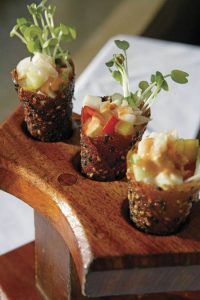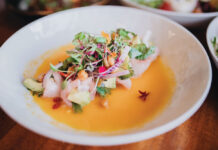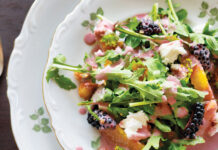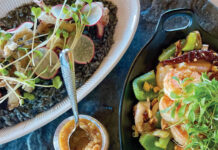Shannon Wianecki | Photography by Jason Moore
 I’m an omnivore. By choice and profession, I’ve cast my lot with those who eat high on the food chain. A phobia of cholesterol (and my environmentalist heart) may prompt me to abandon flesh in the future, but I haven’t yet chiseled down my incisors. Still, I wonder . . . could I do it? Could I—with my greedy, gourmet hankerings—turn vegetarian? I recently experimented the best way I know how: feasting lavishly at Maui’s top restaurants. Can fava beans turn the head of a foie-gras lover? Read on, ye of little faith.
I’m an omnivore. By choice and profession, I’ve cast my lot with those who eat high on the food chain. A phobia of cholesterol (and my environmentalist heart) may prompt me to abandon flesh in the future, but I haven’t yet chiseled down my incisors. Still, I wonder . . . could I do it? Could I—with my greedy, gourmet hankerings—turn vegetarian? I recently experimented the best way I know how: feasting lavishly at Maui’s top restaurants. Can fava beans turn the head of a foie-gras lover? Read on, ye of little faith.
Spago
Sleek furnishings . . . savvy waitstaff . . . breadbaskets brimming with crisp sourdough. (Crisp! In the tropics!) Any way you slice it, dinner at Spago is a luxurious event—even if you do skip the delectable lamb chops.
Luxury doesn’t require clogged arteries. Executive Chef Cameron Lewark claims his four-star menu makes the health grade, too. “Because of our Asian influences, we use less oil, less butter in the kitchen,” he says. While the menu doesn’t actually list a vegetarian entrée, the chef claims to have “four or five veggie options always in my pocket.”
Vegetarians can be “very picky,” remarks Chef Lewark, who seems to enjoy the challenge. “I teach my waiters to get as much information from the guest as possible.” He uses that as a platform to create a special meal. “Vegetarian food, to me, tends to be somewhat bland. I like to give guests big, intense, bold flavors, things they haven’t tried before.”
My adventure starts with a veggie version of Spago’s signature appetizer: the sesame-miso cones. Fresh heart of palm spiced with chili aioli and daikon sprouts replace raw cubes of ‘ahi as filling for the crunchy, slightly sweet cones. The substitution loses nothing of the original appetizer’s textural magic. Chef Lewark praises heart of palm—his favorite vegetable canvas. “It takes on every flavor you want to give it, like a sponge. And,” he adds, “it’s beyond healthy for you. It’s got so much calcium.”
I could eat 20 of these chic little cones, but I bravely forge on.
The next dish makes good on the chef’s promise: a bold and arrestingly beautiful tomato trio. Between a lovely micro-salad and tomato “cappuccino” sits a shot glass of clear liquid topped with electric green oil. My guest dives into the cappuccino, pronouncing the smooth, sumptuous soup capped with froth, cracked pepper, and reggiano the best she’s ever had. I’m transfixed by the liquid, which turns out to be tomato water with a float of basil oil. It tastes clarifying, mildly astringent, not something I’d seek out on its own, but definitely memorable. The greedy gourmand in me is pleased.
Of the six curry specialties Chef Lewark can produce on the fly, his favorite is pineapple coconut. I sample a small bowlful: luxuriant and dazzlingly light on the tongue, with lively green snap peas, eggplant, and fresh cilantro.
“The most important thing is not how you cook, but the product that you start with,” says Lewark. He relies on local farms for the freshest produce, delivered every other day. “It’s out of the ground and on the plate within one or two days.” He’s taken his entire staff—waiters included—on field trips to Fresh Island Herbs, supplier of the tasty microherbs that dress up almost every dish. “It’s important for my staff to see from the ground to the plate,” says the chef. “They need to believe in what they’re selling.”
Amazingly, this from-the-ground-up philosophy reaches to the top rung of the corporate ladder. Spago owner and celebrity chef Wolfgang Puck recently announced that his 137-restaurant and catering empire is switching entirely to USDA organic produce.
Recognizing that human health directly relates to the health of the planet, Puck’s comprehensive new plan specifies using only sustainable seafood, eggs from cage-free hens, and meats from farms compliant with animal welfare standards. It also eliminates foie gras from all menus.
Bravo! If Puck can do it, I can too.
Mala
The conversation continues at Mala Ocean Tavern. This tiny restaurant won this year’s ‘Aipono Award for Best Vegetarian Menu and it has a front-row view of turtles bobbing in the surf. Executive Chef Gregory Denton greets me with creamy edamame “guacamole” and pear tomatoes served on flax bruschetta, drizzled in a finger-licking-good aged balsamic.
Chef Denton hails from the Culinary Institute of America via Terra, a much-lauded restaurant in Napa Valley. “I wanted to relax,” he says, “and not feel as old as I felt in Napa.” It was natural for him to team up with Hawai‘i Regional Cuisine pioneer Chef Mark Ellman. Ellman’s Maui Taco restaurants celebrate “Mauitude” with healthy, island-inspired versions of Mexican dishes. At Mala, the pair dishes up sophisticated health-consciousness with an unbeatable view.
“Part of our mission is to make a healthier atmosphere,” says Chef Denton. “We have Hoison baby-back ribs, we have the Caramel Miranda, but we really do try to balance the diet for customers without them really knowing it.” Wholesome, organic ingredients hide everywhere on Mala’s menu: in wild and brown rice, baby greens, soup stock—even the bottled ketchup is organic. While Chef Denton loves eating and cooking meat himself (“I’m a big fan of eating head to tail, respecting the entire beast,” he says), he knows how to wow with garden-grown delights. The vegetarian Gado Gado and Mediterranean quartet (a generous spread of hummus, flax crackers, and babaganoush) are two staple dishes that regular diners insist remain on the menu. Zesty sugar snap peas served with fiery sambal and fresh ginger are my personal favorite.
“The way culinary arts have to go now is sustainable and organic,” says Chef Denton.
“That’s not a trend; that’s a lifestyle change that needs to happen.” He talks passionately about the power the food industry wields over natural resources. “We’re the gatekeepers,” he says. “We’re the ones that will control what happens in the future regarding sustainability. He blasts food purveyors for coloring salmon with iodine pills and using “scary” hydrogenated oils. (“That Snickers bar,” he says, “is really a plastic toy.”) In contrast, everything served at Mala is transfat-free—including the absolutely delicious Infinity brand French fries. But, the chef reminds me, transfat-free is by no means fat-free.
“The problem with healthy restaurants in general is their lack of fat,” says Denton. And fat, most foodies would agree, is flavor. “When I’m serving you fat, I want to make sure it’s good fat: whole cream and 100 percent pure olive oil,” he says.
As if on cue, out comes a smart-looking dish of fava beans, roasted whole in the pod, splashed with lemon oil, parsley, and thick shavings of pecorino cheese. I’ve tussled with favas in my own kitchen—unzipping their spongy pods, cooking, peeling, and finally finding the wee, shriveled beans unworthy of the effort.
These roasted delicacies, however, are a tribute to the multitudinous vitamins they contain. Denton is dead-on about good fat; the oil and cheese add irresistibility to the dish. The satisfied look on my face as I move onto dessert clearly pleases him.
“The best part of being a chef,” says Denton, “is that you’re in the middle. You’re the median between this farmer who’s so passionate about his small crop of blueberries and someone who’s about to have the best blueberry of his or her life.”
With such tantalizing tomatoes, fantastic favas, angelic curries, aged balsamics, and possibly the best blueberries in my life to look forward to—who needs the meat?





